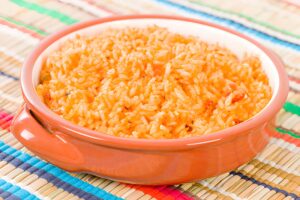Yes, Mexican rice is gluten free. That might come as a relief if gluten gives you trouble or if you are cooking for someone who avoids it.
It is no surprise when many ask is Mexican rice gluten free because traditional Mexican rice is mostly composed of rice, vegetable or chicken broth, tomatoes, onions, and garlic. The majority of variations of this well-liked side dish are suitable for a gluten-free diet because none of these items naturally contain gluten.
The first step in determining whether Mexican rice is gluten-free is to examine the ingredients. Rice doesn’t contain gluten by nature. Naturally gluten-free foods include peppers, tomatoes, onions, and garlic. Gluten is absent from spices like paprika, chili powder, and cumin. If you buy the correct kind, even broth can be gluten-free. Pre-made mixes or commercial seasonings should be avoided above all else. Some of these may include gluten-containing fillers or additives. Knowing is Mexican rice gluten free helps avoid confusion when selecting products.
Mexican rice is almost always gluten-free when prepared at home. You have more control over what gets into the dish when you use fresh ingredients and read the labels on packaged goods. Maltodextrin or wheat flour are frequently used as thickeners in store-bought Mexican rice mixes. Here’s where gluten may infiltrate. Making your own rice guarantees that your meal won’t include any hidden gluten. Understanding is Mexican rice gluten free ensures that homemade preparation is safe.
Is Mexican Rice Gluten Free
Yes, there is no gluten in Mexican rice. If you have issues with gluten or are cooking for someone who doesn’t eat it, that can be a relief.
Restaurants can be more challenging. Some Mexican eateries utilize gluten-containing bouillon cubes or boil rice in communal pots. One worry is cross-contamination. Maintaining a gluten-free diet is made easier by inquiring about the ingredients and preparation method. Never assume that every restaurant version is gluten-free; it’s always wiser to double check. Confirming is Mexican rice gluten free at restaurants prevents accidental gluten exposure.
Regional and cook-specific variations exist in Mexican rice recipes. Tomato paste or sauce, which is inherently gluten-free, is used in some recipes. Others include canned soups or soy sauce, which may contain gluten. Labels must be checked if a recipe calls for certain items. There is gluten-free soy sauce that can be used in place of ordinary soy sauce without compromising flavor. For anyone unsure, asking is Mexican rice gluten free provides clarity before cooking.
See also: Gluten free cheese buns
There are numerous varieties of rice. Mexican rice is often made with long grain rice. Basmati rice or jasmine rice can also be used. There is no gluten in any of these varieties. Another choice is brown rice, which is inherently gluten-free. Only the seasonings and other components can affect whether a dish includes gluten; the type of rice used has no bearing. Checking whether is Mexican rice gluten free helps maintain safe meal planning.
The gluten content is not altered by cooking techniques. The rice stays gluten-free whether it is cooked in a rice cooker, skillet, or saucepan. What comes into contact with the rice when it is cooking is what counts. Gluten can be introduced by using pots or utensils that have been used for gluten-containing dishes without being cleaned. It’s a good idea to keep different cooking supplies for gluten-free meals. Asking whether is Mexican rice gluten free when following new recipes ensures safety and peace of mind.
Mexican rice that is packed or frozen may seem convenient, but it’s crucial to read the labeling. Soy sauce or flavor packets containing wheat flour are present in certain frozen premade rice. Always pay close attention to the ingredient list. Although a gluten-free food is usually safe, it’s a good idea to double-check to avoid any surprises.
Mexican rice goes well with a lot of gluten-free recipes. Vegetables, beans, grilled chicken, and tacos all go well together. You can also use the rice as a side dish for stews or soups. You may add taste and texture without worrying about gluten contamination because the rice itself is gluten-free.
Portion control is important even if Mexican rice is gluten-free. The high carbohydrate content of rice has an impact on blood sugar levels. Being gluten-free does not always equate to being healthy. A meal is balanced when it contains lean proteins and veggies. Instead of being the primary source of nutrition, the rice acts as a basis.
Although they can occasionally include gluten, spices improve Mexican rice. Cumin, garlic powder, and chili powder are OK. Certain spice mixtures contain gluten-based anti-caking ingredients. Buying individual spices rather than pre-mixed blends lowers the risk. The safest choice for anyone avoiding gluten is still fresh ingredients.
You can securely keep leftovers. Mexican rice that has been cooked freezes well. Thoroughly reheat after storing in sealed containers. Gluten content is unaffected by freezing. Rice is preserved, keeping meals safe and convenient.
Gluten content is unaffected by cultural differences. Local veggies or mild spices are used in Mexican rice in various places. These modifications impact the rice’s flavor but not its gluten-free status. It’s safe to use a basic recipe of rice, tomato, onion, garlic, and stock.
Be careful when dining out. Some Mexican eateries cook rice with flour tortillas and breaded items, or they utilize premade flavor mixtures. Shared surfaces or utensils can spread gluten. Risk can be decreased by letting restaurant employees know about gluten restrictions.
There are several meanings for the term “Mexican rice.” It is referred to as Spanish rice in some places. Ingredients don’t change. Until gluten-containing ingredients are added to the dish, the gluten-free status remains unchanged. If no gluten-containing flour or soy sauce is used, rice meals made with tomatoes are inherently gluten-free.
For gluten-free diets, rice is a flexible food. Mexican rice has flavor without causing gluten issues. It can be mixed with beans and veggies, eaten as a side dish, or used to burrito bowls. For those who are gluten intolerant, the dish offers flavor, carbohydrates, and contentment.
More and more commercial Mexican rice is being branded gluten-free. Producers are aware of consumer demand for gluten-free products. Reassurance is offered by products bearing certified gluten-free labels. Ingredient checking is required if a product does not have this label.
It’s easy to make Mexican rice from scratch. In oil, sauté the garlic and onion. Lightly add the toast and rice. Add the seasonings, broth, and tomato sauce and stir. Reduce the heat until the liquid is absorbed. Control over the gluten content is ensured by this procedure. Homemade rice prevents shocks present in certain store-bought varieties.
Others include extras like corn, carrots, or peas. Naturally, these additions don’t include gluten. You can safely add shredded beef or chicken as well, provided that no seasonings that contain gluten are used. When rice is customized, it can be used for a full meal without posing a gluten concern.
Gluten is not necessary for the flavor of Mexican rice. Rich tomato base, sautéed vegetables, and spices create the characteristic taste. Neither the flavor nor the texture are improved by gluten. For people who are gluten intolerant, the whole experience can be had safely by following a traditional recipe.
It is crucial to remember that people with celiac disease and gluten sensitivity must strictly avoid gluten. Carefully prepared Mexican rice is compatible with this diet. To make sure the food is safe, read the labels, inspect the ingredients, and cook carefully.
A dependable gluten-free choice is Mexican rice. Traditionally, it is made with rice, broth, vegetables, and spices. Gluten contamination can be avoided by avoiding pre-made mixtures or by checking ingredients. Because of its adaptability, it may be used with a wide variety of dishes, making it a mainstay in gluten-free cuisine.
Enjoyment is unaffected by eating gluten-free. Without gluten, Mexican rice offers warmth, color, and flavor. Safety is maintained by cooking at home, choosing food carefully, and paying attention when dining out. This traditional dish is safe for everyone to eat without gluten.
Is Mexican rice gluten free? can be easily answered by being aware of the components and preparation techniques. It’s a safe option because it uses fresh ingredients and straightforward cooking methods. It can be a regular element of a gluten-free, well-balanced diet.


